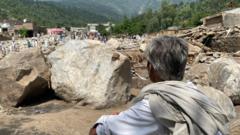Nestled among the lush green mountains of Pakistan's north, the village of Bishnoi once stood as a picturesque community. However, on August 15, disaster struck when heavy rains triggered flash floods, transforming the serene landscape into a scene of destruction. Local residents reported that a sudden surge of water brought with it massive debris, obliterating homes and burying entire neighborhoods.
When BBC Urdu reported from the ground, the village was awash with rubble, including large boulders, concrete blocks, and uprooted trees. The local population, without heavy machinery, worked tirelessly, using basic tools to search through debris in a desperate attempt to find survivors. “There is a house under every stone. People try to look under these rocks to see if they can find someone,” said local Israr Khan.
The devastating floods have impacted the broader Khyber Pakhtunkhwa province significantly, leading to at least 314 confirmed deaths and leaving 156 others injured due to the torrential rains that began late Thursday evening. The Buner district was particularly hard-hit, reporting 217 fatalities as detailed by the Provincial Disaster Management Authority (PDMA). Witnesses described the tragedy in Bishnoi, recounting how a wedding celebration turned into disaster as the floodwaters swept in.
Monsoon season typically spans from June to September in South Asia, accounting for about three-quarters of the region's annual rainfall, but this year's rains have proven particularly deadly, with a total of 507 reported deaths across Pakistan. This crisis is exacerbated by the impacts of climate change, as glaciers in the mountainous regions continue to recede, making the area increasingly susceptible to landslides and flooding.
In addition to the lives lost, many families have been displaced, with an estimated 50% of houses in Bishnoi rendered uninhabitable. Recovery efforts are complicated by forecasts of continued heavy rainfall, likely extending the disaster. Communities throughout the region, including schools, have been forced to respond quickly to the rising waterways. In a notable example, a school principal in Swat Valley managed to evacuate nearly 900 students just moments before the floodwaters inundated the building.
Rescue operations are ongoing. However, many residents remain unaccounted for, and despair fills the streets as family members search for loved ones amid the wreckage. Humanitarian groups and military personnel have mobilized to provide relief, distributing supplies and setting up medical camps to assist survivors.
In the aftermath, the local community, alongside support from neighboring regions, has united to aid in cleanup and recovery efforts, underscoring resilience amid tragedy. "The search is ongoing," said a community member, lamenting the loss but highlighting the determination of both survivors and volunteers to rebuild and recover despite overwhelming grief and devastation.



















